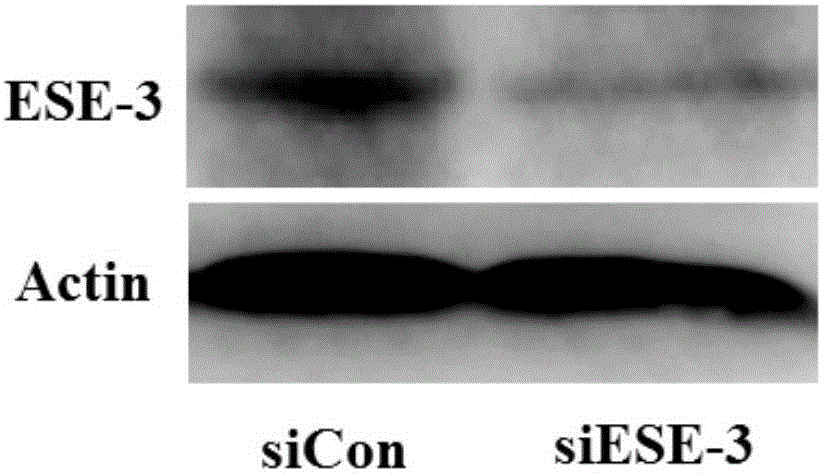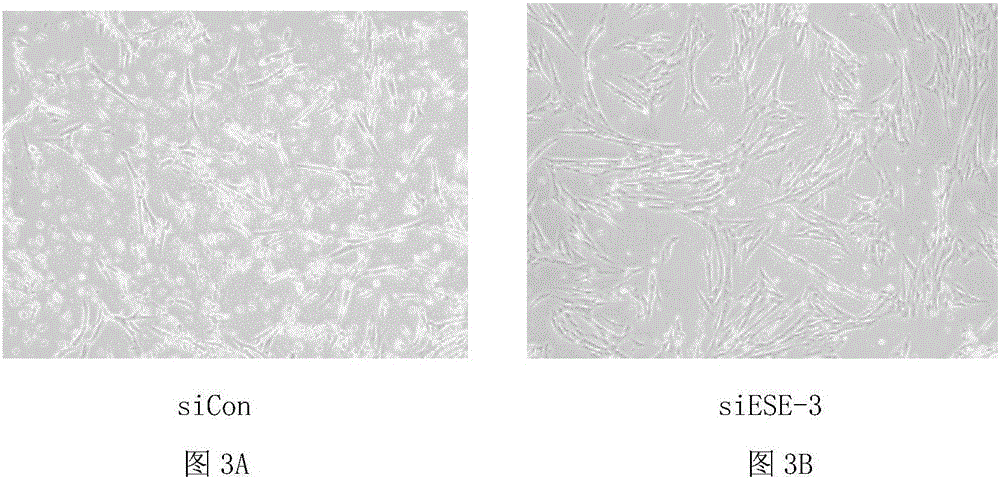Ischemia hypoxia-resistant human mesenchymal stem cells, and preparation method and application
A kind of stem cell and stem cell technology, which is applied in the directions of genetically modified cells, botanical equipment and methods, biochemical equipment and methods, etc., to achieve the effects of simple technology, improved survivability, and reduced death
- Summary
- Abstract
- Description
- Claims
- Application Information
AI Technical Summary
Problems solved by technology
Method used
Image
Examples
Embodiment 1
[0025] A method for preparing human mesenchymal stem cells that stably interfere with ESE-3 gene ischemia and hypoxia resistance, comprising the following steps:
[0026] Isolation and culture of human placental mesenchymal stem cells, detection of ESE-3 gene expression and preparation of placental mesenchymal stem cells transfected with siRNA targeting ESE-3.
[0027] 1) Isolation of placental mesenchymal stem cells: the human placenta tissue was shredded mechanically, and the placental mesenchymal stem cells were obtained by enzymatic digestion method well known to professionals.
[0028] 2) Expansion and culture of placental mesenchymal stem cells: the above cells were divided into 0.5-5×10 5 / cm 2 Inoculate the culture flask at a density of 37°C, saturated humidity, 5% CO 2 Primary cell cultures were performed in an incubator. The medium used was serum-free medium. When cells are cultured to 80-90% confluence, use trypLE TM Digest and inoculate into new culture flasks...
Embodiment 2
[0033] A method for preparing human mesenchymal stem cells resistant to ischemia and hypoxia without exogenous gene insertion, comprising the following steps:
[0034] 1) Isolation and expansion of human mesenchymal stem cells: the umbilical cord tissue was cut into pieces mechanically, and the umbilical cord mesenchymal stem cells were isolated according to the conventional tissue block attachment method.
[0035] 2) Place the obtained umbilical cord tissue block at 37°C, saturated humidity, 5% CO 2Primary cell cultures were performed in an incubator. The medium used was DF12 medium containing 10% fetal bovine serum. When the cells were cultured to 80-90% confluence, they were digested with trypsin and inoculated into new culture flasks at a split ratio of 1:3. After several passages, the obtained mesenchymal stem cells can be used for subsequent operations;
[0036] 3) Transfect the synthesized siRNA interference fragment (targeting sequence: GCCGAGCTATGAGATATTA) (SEQ ID ...
Embodiment 3
[0039] Interfering with ESE-3 gene can significantly improve the survival of mesenchymal stem cells under severe hypoxic conditions.
[0040] We simulated a hypoxic environment through a three-gas incubator, with normoxia at 21% oxygen content and severe hypoxia at 1% oxygen content, and cultured cells with medium containing 2% serum. Mesenchymal stem cells were infected with a lentiviral vector carrying shRNA targeting ESE-3, the shRNA sequence was GCCGAGCTATGAGATATTA TCAAGAG TAATATCTCATAGCTCGGC (SEQ ID NO: 2), and the control group used a nonsense shRNA lentiviral vector, and the two groups of cells were respectively Inoculate into 6-well plate and 96-well plate, the normoxic environment is 21% oxygen content, 5% carbon dioxide, the hypoxic group is placed in 1% oxygen content, 5% carbon dioxide environment and cultured for 72 hours, and the cells in the 6-well plate are photographed to observe the cells Morphology, 96-well plate cells were subjected to MTT assay.
[0041] ...
PUM
 Login to View More
Login to View More Abstract
Description
Claims
Application Information
 Login to View More
Login to View More - Generate Ideas
- Intellectual Property
- Life Sciences
- Materials
- Tech Scout
- Unparalleled Data Quality
- Higher Quality Content
- 60% Fewer Hallucinations
Browse by: Latest US Patents, China's latest patents, Technical Efficacy Thesaurus, Application Domain, Technology Topic, Popular Technical Reports.
© 2025 PatSnap. All rights reserved.Legal|Privacy policy|Modern Slavery Act Transparency Statement|Sitemap|About US| Contact US: help@patsnap.com



